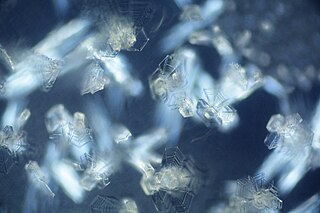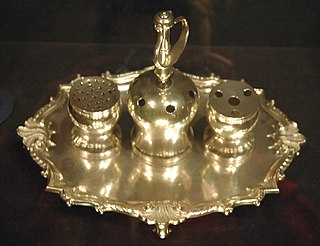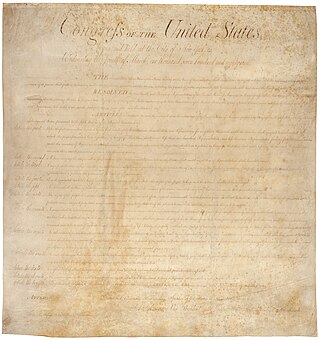
Magna Carta Libertatum, commonly called Magna Carta or sometimes Magna Charta, is a royal charter of rights agreed to by King John of England at Runnymede, near Windsor, on 15 June 1215. First drafted by the Archbishop of Canterbury, Cardinal Stephen Langton, to make peace between the unpopular king and a group of rebel barons, it promised the protection of church rights, protection for the barons from illegal imprisonment, access to swift and impartial justice, and limitations on feudal payments to the Crown, to be implemented through a council of 25 barons. Neither side stood by their commitments, and the charter was annulled by Pope Innocent III, leading to the First Barons' War.

The Declaration of Independence, formally titled The unanimous Declaration of the thirteen united States of America, is the founding document of the United States. On July 4, 1776, it was adopted unanimously by the 56 delegates to the Second Continental Congress, who had convened at the Pennsylvania State House, later renamed Independence Hall, in the colonial era capital of Philadelphia. The declaration explains to the world why the Thirteen Colonies regarded themselves as independent sovereign states no longer subject to British colonial rule.

The Universal Declaration of Human Rights (UDHR) is an international document adopted by the United Nations General Assembly that enshrines the rights and freedoms of all human beings. Drafted by a UN committee chaired by Eleanor Roosevelt, it was accepted by the General Assembly as Resolution 217 during its third session on 10 December 1948 at the Palais de Chaillot in Paris, France. Of the 58 members of the United Nations at the time, 48 voted in favour, none against, eight abstained, and two did not vote.
Civil liberties are guarantees and freedoms that governments commit not to abridge, either by constitution, legislation, or judicial interpretation, without due process. Though the scope of the term differs between countries, civil liberties may include the freedom of conscience, freedom of press, freedom of religion, freedom of expression, freedom of assembly, the right to security and liberty, freedom of speech, the right to privacy, the right to equal treatment under the law and due process, the right to a fair trial, and the right to life. Other civil liberties include the right to own property, the right to defend oneself, and the right to bodily integrity. Within the distinctions between civil liberties and other types of liberty, distinctions exist between positive liberty/positive rights and negative liberty/negative rights.

The Bill of Rights 1689 is an Act of the Parliament of England that set out certain basic civil rights and clarified who would be next to inherit the Crown. It remains a crucial statute in English constitutional law.

Water vapor, water vapour or aqueous vapor is the gaseous phase of water. It is one state of water within the hydrosphere. Water vapor can be produced from the evaporation or boiling of liquid water or from the sublimation of ice. Water vapor is transparent, like most constituents of the atmosphere. Under typical atmospheric conditions, water vapor is continuously generated by evaporation and removed by condensation. It is less dense than most of the other constituents of air and triggers convection currents that can lead to clouds and fog.

Ice crystals are solid ice in symmetrical shapes including hexagonal columns, hexagonal plates, and dendritic crystals. Ice crystals are responsible for various atmospheric optic displays and cloud formations.
An inert gas is a gas that does not readily undergo chemical reactions with other chemical substances and therefore does not readily form chemical compounds. The noble gases often do not react with many substances and were historically referred to as the inert gases. Inert gases are used generally to avoid unwanted chemical reactions degrading a sample. These undesirable chemical reactions are often oxidation and hydrolysis reactions with the oxygen and moisture in air. The term inert gas is context-dependent because several of the noble gases can be made to react under certain conditions.

The National Archives Building, known informally as Archives I, is the headquarters of the United States National Archives and Records Administration. It is located north of the National Mall at 700 Pennsylvania Avenue, N.W. in Washington, D.C. The rotunda entrance is on Constitution Avenue, and the research entrance is on Pennsylvania Avenue. A second larger facility, Archives II, also known as A2, is located in College Park, Maryland.

The United States Constitution has served as the supreme law of the United States since taking effect in 1789. The document was written at the 1787 Philadelphia Convention and was ratified through a series of state conventions held in 1787 and 1788. Since 1789, the Constitution has been amended twenty-seven times; particularly important amendments include the ten amendments of the United States Bill of Rights and the three Reconstruction Amendments.

Jacob Shallus or Shalus was the engrosser or penman of the original copy of the United States Constitution. The handwritten document that Shallus engrossed is on display in the Rotunda of the Charters of Freedom at the National Archives Building in Washington, D.C.
A hermetic seal is any type of sealing that makes a given object airtight. The term originally applied to airtight glass containers, but as technology advanced it applied to a larger category of materials, including rubber and plastics. Hermetic seals are essential to the correct and safe functionality of many electronic and healthcare products. Used technically, it is stated in conjunction with a specific test method and conditions of use. Colloquially, the exact requirements of such a seal varies with the application.

The Syng inkstand is a silver inkstand used during the signing of the United States Declaration of Independence in 1776 and the United States Constitution in 1787. Besides paper documents, it is one of four still-existing objects that were present during the Constitutional Convention, along with the Liberty Bell, the chair that George Washington sat in as the Constitutional Convention's presiding officer, and Independence Hall itself.

The United States Bill of Rights comprises the first ten amendments to the United States Constitution. Proposed following the often bitter 1787–88 debate over the ratification of the Constitution and written to address the objections raised by Anti-Federalists, the Bill of Rights amendments add to the Constitution specific guarantees of personal freedoms and rights, clear limitations on the government's power in judicial and other proceedings, and explicit declarations that all powers not specifically granted to the federal government by the Constitution are reserved to the states or the people. The concepts codified in these amendments are built upon those in earlier documents, especially the Virginia Declaration of Rights (1776), as well as the Northwest Ordinance (1787), the English Bill of Rights (1689), and Magna Carta (1215).

The conservation and restoration of parchment constitutes the care and treatment of parchment materials which have cultural and historical significance. Typically undertaken by professional book and document conservators, this process can include preventive measures which protect against future deterioration as well as specific treatments to alleviate changes already caused by agents of deterioration.

A bill of rights, sometimes called a declaration of rights or a charter of rights, is a list of the most important rights to the citizens of a country. The purpose is to protect those rights against infringement from public officials and private citizens.

The Aerial Regional-scale Environmental Survey (ARES) was a proposal by NASA's Langley Research Center to build a robotic, rocket-powered airplane that would fly one mile above the surface of Mars, in order to investigate the atmosphere, surface, and sub-surface of the planet. The ARES team, headed by Dr. Joel S. Levine, sought to be selected and funded as a NASA Mars Scout Mission for a 2011 or 2013 launch window. ARES was chosen as one of four finalists in the program, out of 25 potential programs. However, the Phoenix mission was ultimately chosen instead.

The physical history of the United States Declaration of Independence spans from its original drafting in 1776 into the discovery of historical documents in modern time. This includes a number of drafts, handwritten copies, and published broadsides. The Declaration of Independence states that the Thirteen Colonies were now the "United Colonies" which "are, and of Right ought to be Free and Independent States"; and were no longer a part of the British Empire.
Picture framing glass usually refers to flat glass or acrylic ("plexi") used for framing artwork and for presenting art objects in a display box.

Joel S. Levine is an American planetary scientist, author, and research professor in applied science at the College of William & Mary, specializing in the atmospheres of the Moon, Earth, and Mars. He has worked as a senior research scientist at NASA, developing scientific models of the evolution of the Earth's early atmosphere, as well as creating models of the Martian atmosphere for use during the Viking 1 and 2 Mars Orbiter and Lander Missions, and was principal investigator and chief scientist of the proposed ARES Mars Airplane Mission. He also formed and led the "Charters of Freedom Research Team," a group of 12 NASA scientists who worked with the National Archive and Records Administration (NARA) to preserve the United States Declaration of Independence, the Constitution, and the Bill of Rights when small white spots began appearing on the documents in 1988. Levine's past work also includes assisting in the design of the rescue vehicle that saved 33 Chilean miners in the 2010 Copiapó mining accident, as well as original research on the feasibility of the "nuclear winter" hypothesis, and the effects of uncontrolled fires on global warming.


















